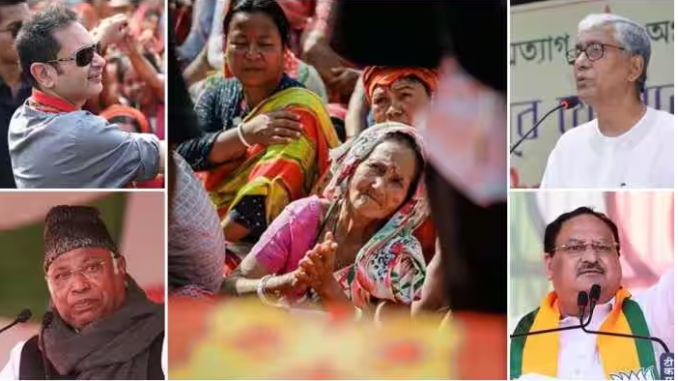
Tripura Assembly Elections 2023: Tripura will be voting for 60 assembly seats tomorrow and the polls are likely to be a triangular fight. While the BJP, which came to power in the state ending decades-long rule of the Left parties, is seeking a second term on the development plank, the entry of Mamata Banerjee’s TMC and Pradyot Kishore Manikya Debbarma-led Tipraha Indigenous Progressive Regional Alliance (TIPRA) Motha has created a sense of insecurity in the BJP and the Left-Congress alliance. Debbarma is a former Congress leader and scion of the former royal family of Tripura. He holds a strong command over Tripura’s indigenous tribes and peoples and thus, is being projected as a kingmaker in this election. There are around 20-25 constituencies where tribal voters play a decisive role and Tipra Motha can have an edge over other parties.
Tipra Motha: The Rise of ‘People’s Movement’
Debbarma often refers to Tipra Motha as a movement rather than a political party. Debbarma resigned from Congress in 2019 and formed a separate social organisation to push for the rights of the indigenous people of Tripura. Ahead of the 2021 Tripura Tribal Areas Autonomous District Council election, Debbarma made his intentions clear to contest the polls while converting his social organisation into a political party. He got immense support from regional parties as the Indigenous Nationalist Party of Twipra (INPT), Tipraland State Party (TSP) and IPFT (Tipraha) merged with the TIPRA in 2021 and to everyone’s surprise, the party won the TTAADC polls in April 2021 by bagging 18 out of the 30 seats. By this time, the BJP and the Congress sensed the potential that Tipra Motha holds and they even tried to stitch up an alliance with the Tipra but Debbarman chose to contest alone as neither BJP nor Congress was ready to promise a separate Greater Tipraland state. Another reason for the rise of Tipra Motha is that tribals still revere the erstwhile royal family and they refer to Debbarma as ‘Bubagra’ or king.
Tipra Motha: Key Demands/Promises of the Party
Tipra Motha thrives on the core ideological demand of a separate state called Greater Tipraland. The party believes that the government of Tripura have failed to fulfil the needs and demands of the indigenous people of the state and thus only a separate state for the 19 indigenous tribes of Tripura under Articles 2 and 3 of the Constitution can lead to the overall development of these people/tribes. The Greater Tipraland state includes areas beyond the TTAADC jurisdictions and includes several other villages inhabited by the Tiprasa (indigenous people of Tripura).
The Tipra Motha also promises to set up task forces to help the Tiprasa with their linguistic, cultural, social, and economic development. The genesis of the demand for the Greater Tipraland appears to be from the demand for a separate state called Tipraland put forth first by the Indigenous People’s Front of Tripura (IPFT) in 2009. However, when the IPFT joined hands with the BJP, it agreed to the Common Minimum Programme under which the Centre constituted a panel for the socio-economic and linguistic development of the tribals. This alienated the support base that the IPFT had acquired over a decade due to the demand for a separate state. The same vote bank has now conveniently shifted towards the Tipra Motha. However, the demand by the Tipra Motha includes 36 more villages beyond the TTAADC areas.
The other promises as per the vision document of the party are a speedy public grievance redressal system, empowerment of TTAADC through a hike in financial allocation, 20,000 new jobs, land patta to deprived persons, the establishment of Tribal University, Agriculture University, Sports University and Buddhist University, doorstep delivery of government scheme, the socio-economic survey of tribes, plans to achieve zero poverty-zero violence-zero corruption and resolution against Citizenship Amendment Act (CAA).
Why a Separate State?
The demographics of Tripura have altered significantly in the past few decades. As per reports, the 1941 Census, the state’s population consisted of equal numbers of tribals and non-tribals as their ratio was around 50:50. However, the influx of migrants from East Pakistan (now Bangladesh) reduced tribal to non-tribal population ratio to 37:63. This all happened well before Bangladesh came on the world map. The influx of refugees led to conflict between the tribals and the non-tribals which further escalated into an armed insurgency by the 1980s. This further led to demand for an autonomous region or separate statehood that even continues today even after a political truce was reached between the State and the rebel groups.
Challenges for the BJP-IPFT and Left-Congress Alliances
Tipra Motha has been successful in mobilising majority of tribals and a significant chunk of non-tribals through its movement. The political front has almost polarised the TTAADC regions and the scale hangs in the favour of Motha leaders. Despite the BJP claiming to win the polls with a significant majority, their concerns related to Tipra Motha’s rise can be sensed from the saffron party’s manifesto. The BJP in its manifesto promised greater legislative, executive and financial powers to the Tripura Tribal Areas Autonomous District Council (TTAADC) in a bid to counter the aggressive campaign by the Tipra Motha. The BJP claimed in its manifesto that the party will achieve permanent political solutions in a time-bound manner by taking all constitutional, legal, executive and administrative measures without affecting the territorial integrity of the council. The Left-Congress too, in its manifesto, favoured empowerment of the TTAADC by amending the 125th Constitution and promised greater autonomy. However, only the election results will tell whether the gamble of greater autonomy by the BJP or the Left has been successful in containing the demand for a separate state. The counting of votes will be held on March 2.
Bureau Report
Leave a Reply